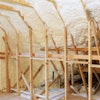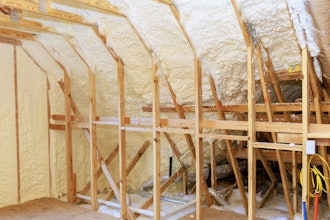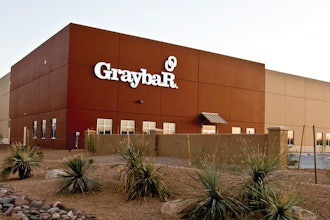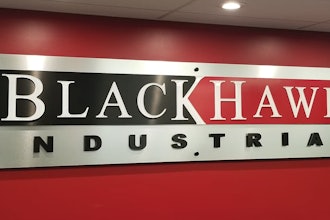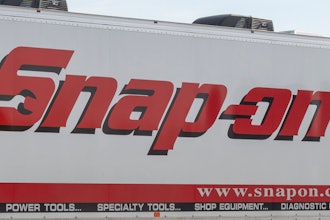HVLS FANS:
Four important factors to consider prior to making a purchase decision
March 2014
WHITE
PAPER
".. .NOT ALL HVLS FANS ARE CREATED EQUAL ."
THE NEW STANDARD
HIGH-VOLUME, LOW-SPEED (HVLS) FANS HAVE
BECOME THE STANDARD FOR LOW-COST, HIGH-
EFFICIENCY CLIMATE CONTROL IN A WIDE VARIETY
OF COMMERCIAL AND INDUSTRIAL APPLICATIONS.
As the name suggests, HVLS fans move large volumes of
air down from the ceiling and across the floor of a building.
This controlled flow of air – from ceiling to floor – creates a
more comfortable and productive work environment, while
helping businesses control their energy costs. Improved
air flow translates to improved temperature control
throughout the year, which ultimately saves money.
A wide variety of businesses – from distribution centers
and manufacturing facilities, to shopping malls and gyms
– are choosing to install HVLS fans. HVLS fans are quickly
replacing antiquated high-speed fans that are noisy, less-
efficient and can take up valuable floor space. Businesses
that are looking to integrate HVLS fans into their facilities
should understand that not all HVLS fans are created equal.
There are significant design and manufacturing variations
that can impact everything from the quality of air movement,
right down to the cost of operation and maintenance.
When researching HVLS fans, there are four
key areas for consideration:
Blade Design
Hub and Mounting
Safety
On-site Consultation
1HVLS fans improve airflow by drawing air down from the ceiling and across
the floor. This helps to improve climate control and energy efficiency.
Rite-Hite fan blades are seated on the hub arm and locked into position
with a machined bolt. In addition, the hubs and blades are rotationally-
balanced and never require adjustment.
Rite-Hite, a leading manufacturer of HVLS fans, constructs
its blades from strong, light-weight aluminum. This produces
a more stable blade that maximizes air movement directly
underneath the fan. In addition, Rite-Hite fan blades have
an advanced, contoured shape (tilt, taper and twist) that
produces consistent airflow across the entire length of the
blade. This unique fan blade design produces the most air,
over the largest area, at the lowest cost when compared to
competitive HVLS fans.
2. HUB AND MOUNTING SYSTEM
The design and construction of the fan blade is important;
however, it’s equally important to look at how the fan
blade is mounted and the overall construction of the hub.
A tight, solid connection between the blade and hub is
critically important.
Similar to the blades of a helicopter, Rite-Hite’s fan blades
are attached to the hub by a pivot. The pivot is surrounded
by a resilient, vibration-absorbing material, which eases
the stress transferred to the hub and drive during operation.
When compared to fans with rigidly- mounted blades, Rite-
Hite blades can reduce stress to the hub and drive by
upwards of 50 percent, which substantially increases the
life of the drive mechanism.
1. BLADE DESIGN
The signature benefit of an HVLS fan is the production of
air volume, which is created by a large diameter fan blade
that can span up to 24 feet. A large fan diameter, however,
is only part of the equation. Each blade must be capable
of efficiently moving air or the result will be wasted energy.
Fan blade design varies by manufacturer, so it is important
to look for a design that produces uniform pressure and
velocity from the hub to the tip of the blade. A lack of uniform
pressure and/or velocity creates a number of issues,
including backflow and increased energy consumption.
To maximize performance, look for a tapered blade design
that is narrow at the tip, where the blade velocity is higher,
and widens toward the hub, where more blade area is
required due to lower blade velocity. Also, it is important to
look at the angle of the blade as it relates to the plane of
rotation. The chord angle of the blade should be minimal at
the tip and gradually increase as it gets closer to the hub.
The overall shape and design of a fan blade is what produces
maximum air volume – not the number of blades. Certain
HVLS fans struggle to produce consistent air movement
because they are made from extruded aluminum. With
extruded blades, the shape or blade angle is uniform from
root to tip, or in other words, there is no blade twist. With
this type of design, there is limited or no air movement
directly underneath the fan center. This is a result of the
blade tip moving most of the airflow and the blade root
producing limited airflow. As a result, some manufacturers
add blades to help compensate, which adds cost to the fan
without increasing performance or value.
2
Rite-Hite fan blades have an advance, contoured shape (tilt, taper and twist)
that produces consistent airflow across the entire length of the blade.
3To schedule an onsite analysis by an HVLS
professional, call Rite-Hite at 888-841-4283
or visit www.ritehite.com to learn more.
Some HVLS fans specify clearances or distances from
other fans or HVAC equipment. Competing air currents can
damage fans that are unable to absorb the forces created
by lift or air pressure.
To ensure a tight connection, Rite-Hite fan blades are
mounted in two specific ways. They are seated on the hub
arm and then locked into position with a machined bolt
that requires a torque setting. In addition, all Rite-Hite
hubs and blades are “rotationally-balanced” at the factory
and will never require adjustment. This ensures smooth
and balanced operation over the lifetime of the fan.
Most HVLS fan manufacturers use a cast hub, which is
created by pouring molten aluminum into a mold. It is
difficult to regulate the consistency of a casting due to
variances in the materials and manufacturing process.
As a result, cast hubs are more porous and susceptible
to cracking. Rite-Hite uses a milled aluminum hub that is
much stronger than a traditional cast hub. A computer-
controlled milling machine is used to remove materials
from a block of aluminum. This process produces a more
durable and reliable hub when compared to a cast hub.
3. SAFETY
Safety is always an important consideration when
purchasing a piece of industrial equipment. Businesses
should look for HVLS fans that offer a three-way motor-to-
hub safety connection. First, look for a hub that attaches
to the motor using a reverse thread bolt and tapered
aluminum bushing. Second, look for a safety ring that
backs up the motor to hub connection. And finally, each
blade arm should be attached to the safety ring. These
three features, working together, help to ensure the safety
of people underneath and around the fan.
4. ON-SITE CONSULTATION
Prior to purchasing HVLS fans, companies should to talk
with a professional who can analyze a specific application.
A consultant will look at things like building size and
operation; the amount of open and confined spaces within
a facility; existing HVAC systems and more. The goal is to
match the right size fan and desired air speed to a specific
floor plan. Rite-Hite offers a wide variety of HVLS fans
and can recommend a solution that is best suited for a
specific application.
HVLS fans are often found in industrial settings like distribution centers and manufacturing facilities, however, they are becoming
more common place in athletic facilities, amphitheaters, malls and other environments where air movement is critical.
Improved air f low translates to improved
temperature control throughout the
year, which ult imately saves money.
HVLS Fans: Four Important Factors to Consider Prior to Making a Purchase Decision
High-Volume, Low-Speed (HVLS) fans have become the standard for low-cost, high-efficiency climate control in a wide variety of commercial and industrial applications. However, not all HVLS fans are created equal. There are significant design and manufacturing variations that can impact everything from the quality of air movement, right down to the cost of operation and maintenance. When researching HVLS fans, there are four key areas for consideration, including: fan blade design, hub and mounting systems, safety features and onsite consultation. All four of these factors must be properly examined in order to select the right HVLS fan for a specific application.
Latest in Home



